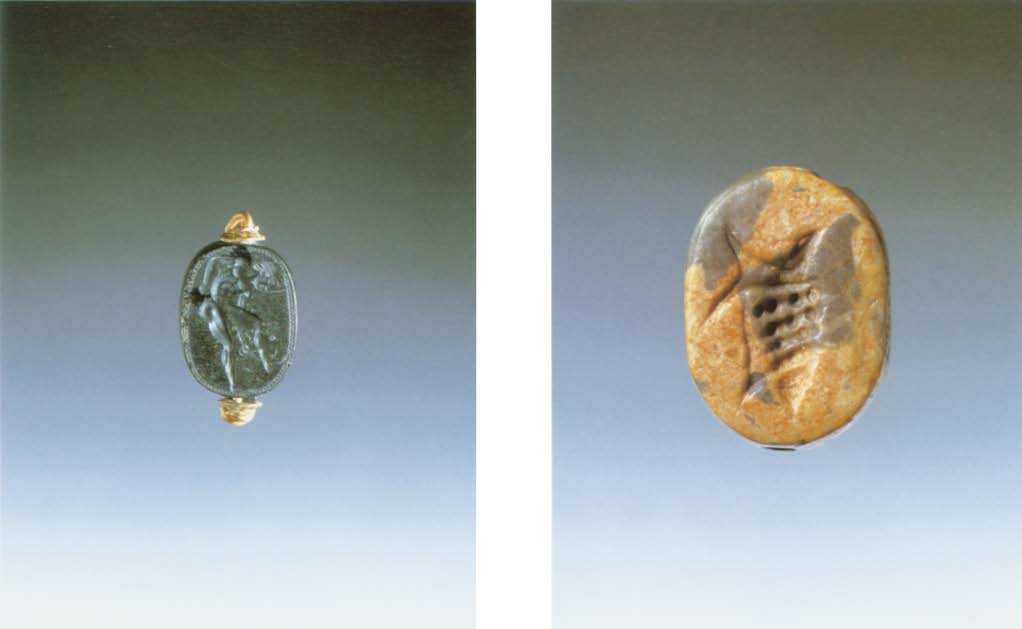Two Greek Gems, Scaraboids, 500 B.C. in the Getty
19 Mottled green and yellow jasper scaraboid
23.3 x 16.8 x 8.7 m m
Greek, late fifth-early fourth century B.C .
85. AN.370.7 (Color plate 2)
Description: Murex shell.
There are a few chips from the sides and back.
Discussion: The treatment of the murex shell is close to that on a Greek bronze ring in London, where the shell is combined with a human head (BMC Rings, no . 1256 ; Boardman, GGFR, fig . 258). Provenance: From Athens.
17. Obsidian scaraboid by the engraver Epimenes
16.2 x 12.9×7.0 mm (as preserved)
Greek, circa 500 B.C .
85. AN.370.6 (Color plate 2)
Description: Nude youth standing left scraping his right leg with a strigil. His upper bod y is shown facing in three-quarter view ; his hair is cross-hatched with a row of pellets representing th e curls along the brow and back of the neck. The strigil terminates in a stylized duck’s head; hatched border. The scaraboid is set in a modern gold ring. Enough of the back of the scaraboid is preserved to reconstruct the profile, which is of conventional Archaic shape; the original height was circ a 8.5 mm. There are small chips from the top and left of the face. Nearly all of the back is broken away and lost.
Discussion: This is the fifth known work of the artist Epimenes, whose signature is found on a gem in Boston, a chalcedony scaraboid on which a youth restrains a horse (Boardman, AGG, no . 246; Beazley, Lewes House, no. 28). The other examples include a chalcedony scaraboid in New York showing a kneeling youth testing an arrow (Boardman, AGG, no . 248); a carnelian scarab with a youth adjusting his sandal, now in the Getty Museum (Boardman, Intaglios and Rings, no . 22 = Getty Museum 81. A N. 76.22); and, less certainly, a second chalcedony scaraboid in Boston depicting a youth shooting an arrow (Boardman, AGG, no . 247; Beazley, Lewes House, no. 27).
The most thorough discussions of the artist and related works are by Boardman (Boardman , Intaglios and Rings, pp . 12-13 ; idem, “Greek Gem Engraving: Archaic
to Classical,” in C. G. Boulter, ed., Greek Art, Archaic into Classical. Cincinnati Classical Studies, vol . 5 [Leiden, 1985], pp- 87-88; Boardman, AGG, pp. 92-94), who
attributed the Getty carnelian scarab to Epimenes.
The new scaraboid in the Getty can be assigned with confidence to Epimenes, and it in turn lends further cohesion to the entire group of gems. The heads of the youths on the new Getty piece and on the signed work in Boston are nearly identical and extremely close to the example in New York (see Boardman, Intaglios and Rings, pis. A-B, for enlarged illustrations). The obsidian scaraboid, clearly by Epimenes, strongly supports Boardman’s attribution of the Getty carnelian scarab, for although the head on the latter piece differs somewhat from the other, the detailing of the body, notably the musculature of the legs and arms and the treatment of the knees and feet, is identical.
The more angular features of the youth on the Getty carnelian scarab resemble those of the archer on the second scaraboid in Boston, although the latter work is less careful than any of the others. The two gems in the Getty differ in several respects from the three previously known gems. The carefully worked carnelian scarab and the scaraboid in the rarely used material obsidian are new to Epimenes’ works, which had consisted only of chalcedony scaraboids.
All five of his gems depict nude youths, but the poses of the two Getty gems are new. The gems in Boston and New York all show the youths in three-quarter rear view, an innovative pose that became popular in sculpture and vase-painting late in the sixth century (see the discussion by Beazley, Lewes House, pp. 21-22) and that was especially ambitious for a gem engraver. On the two gems in the Getty the youths are shown in three-quarter front view, which is not an unusual pose on Archaic gems, although seldom skilfully accomplished.
The two works by Epimenes show different degrees of success. The carnelian scarab is the better of the two, with the chest shown in correct three-quarter view, although the lowered right arm is unnaturally elongated. The youth on the obsidian scaraboid twists so that his upper chest faces entirely to the front, a typical but awkward Archaic stylization, while the lower torso is shown in accurate three-quarter view.
The carnelian scaraboid appears to be the more developed of the two works. Two of Epimenes’ gems were found in Egypt, a third on Aegina, and the Getty obsidian scaraboid allegedly in Sicily. However, the letter forms of his signature suggest he was from one of the Cycladic Islands, and the long tradition of gem engraving in the Islands supports this attribution (see Boardman, AGG, pp. 93-94; Boardman [above], pp. 87-88).
For the motif of a youth with strigil on a number of Archaic gems, see Boardman, Intaglios and Rings, no. 18 = Getty Museum 81. AN.76.18, a carnelian scarab; also Boardman, AGG, nos. 190, 259, and 310. Provenance: From Sicily.



